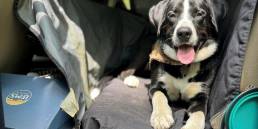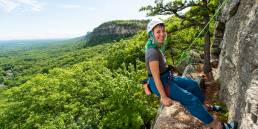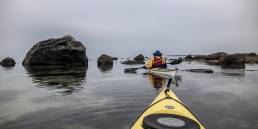The first-of-its-kind Queer Ice Fest happened in the Adirondacks last weekend. Just before it took place, we sat down with it’s organizer, Robbi Mecus, to talk a little bit about her background and motivations for creating this one-of-a-kind event.

goEast: You’ve been climbing for 27 years, nearly three decades!
Mecus: When I first started climbing, I asked the older people how long have they had been climbing and they’d say 25 years and I’d be like ‘oh my god you’ve been climbing as long as I’ve been alive!’ Now I’m that person.
goEast: Why ice climbing?
Mecus: Honestly, I don’t know. When I first started to get into climbing, I was enraptured by the concept of climbing a big mountain. All the rock was covered by snow and ice. So really early on the concept of moving over ice was a very practical one because the goal of climbing big mountains. That was the early allure.
But then when I started ice climbing, I found that it required all the tools of rock climbing: balance, footwork and understanding body positions, plus you are doing it in an environment that is so adverse. I love the challenge of it.
goEast: Is it your favorite kind of climbing?
Mecus: It’s really funny: To me it’s all just climbing. It’s all ascending a feature that appeals to me visually. I like the look of it and whether that feature is a rib of rock, a gully, or a ribbon of ice, it’s all climbing.
goEast: Do you like the gear? Or is the gear a means to an end?
Mecus: I love the gear. Climbing with super sharp ice tools is great. I remember I was living in Queens and going to the 59th Street climbing gym and I bought my first ice axe and I brought it home on the subway and people were legitimately afraid of me. I love that feeling of being set apart from the humdrum of society.
goEast: What was the first thing you climbed with that ice axe?
Mecus: General sort of winter hiking. The ice axe was a long-shafted mountaineering axe, ideal for winter hikes and ascents in the Adirondacks. I carried it everywhere I went and that was before the days trekking poles were a thing. Walking with that axe was almost like carrying a wrecking ball.
goEast: How has the climbing community changed in the past 27 years, in terms of women or LGBTQ folks?
Mecus: I wonder, has the community changed? Or has my perception of the community changed? When I first started climbing I was not out and I was not part of any sort of queer community. I wasn’t aware of anybody who was queer or trans when I first started climbing. I simply wasn’t aware of any of that.
When I came out, I had several climbers that I had known also come out to me, so I think it’s always been there. I do think that that the LGBTQ community is becoming a larger part. Whether it’s being afforded or not, they are sort of demanding it.
goEast: And last weekend was the first Queer Ice Fest in the US. Tell me about it.
Mecus: The idea was born out of getting an LGBTQ beginners clinic into an existing ice festival. I hadn’t thought of queer people doing it on their own, I thought it made more sense to take some space within an existing framework, but that didn’t work.
At one point I said that I wished we could just do this ourselves and somebody said ‘why can’t we?’ I woke up the next day and decided that was the way to do it.
I couldn’t do it alone. I initially had two people and now half a dozen jumping in and doing a lot of the work. If I didn’t have that, I wouldn’t be doing this.

goEast: What are you hoping to get out of an event like this? What are you trying to accomplish?
Mecus: I wanted people to get together and see how many people there are like them. The community is kind of fractured but there really are a lot.
goEast: You also hosted a film night during the Queer Ice Fest. Tell me about the film.
Mecus: Yes the film “They/Them” is about a non-binary climber, Lor Sabourin. It’s a climbing film but it’s also about issues of identity and body image. Lor talks openly about their struggle with eating disorders and their sense of identity and how that impacted their climbing and how their climbing impacted their sense of identity. It’s about a lot more than just climbing.
goEast: What fun climbing adventures are coming up for you after the Queer Ice Fest?
Mecus: I am heading out with another queer climber in late April and we are going to the Ruth Gorge in Alaska to do some long ice and mixed routes on smaller peaks in the Alaska range.
goEast: Is it important for you to do this climbing trip with another queer climber?
Mecus: For me it’s important. It all comes back to representation. I want people to see that trans people can do amazing things. I think it helps when young trans people see other trans people accomplishing things. I think it lets them know that their life doesn’t have to be full of negativity and it can actually be really rad.
goEast: Is it hard to be a young Queer climber today?
Mecus: It’s all a matter of perspective. I think that’s really highly dependent on where that young person is living, what community and what culture they come from.
goEast: You also have an article in the new issue of Alpinist Magazine. What’s it about?
Mecus: I wrote something about doing search and rescue work as a Forest Ranger and the emotions surrounding the work. There’s an attitude out there among the recreating public that Forest Rangers are amazing and super human and they can do anything. We have these amazing people with all these skills but I think there’s this belief that the rescue worker is invincible and superhuman. But we’re obviously not. So I attempted to talk about that a little bit using an actual winter rescue mission that I was on as a backdrop to explore the emotions around search and rescue work and how I deal with the adversity of it by tapping into my past experiences climbing.
goEast: I look forward to reading the new issue of the Alpinist, Robbi. Thank you for chatting with us!
Related Posts
April 24, 2024
What to Bring When Road Tripping with Your Dog
Prepare for the ultimate road trip with…




